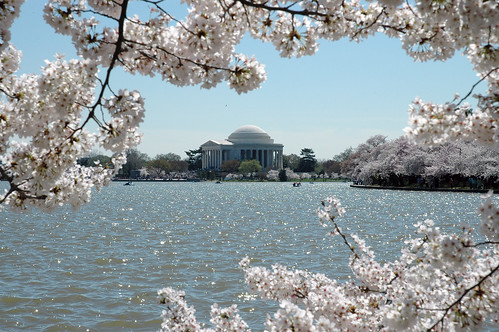
Since 1912, the beautiful pink and white blossoms of the Tidal Basin’s Japanese cherry trees have been one of our national Capital’s most iconic images. For Washingtonians, cherry blossoms herald the beginning of spring and a reprieve, albeit brief, between frosty winter weather (although this winter, not so much) and the sweaty, swampy conditions of summertime. Tourists flock from around the world to the National Cherry Blossom Festival, snapping photographs and attending events across the city. Yet few people realize that DC’s now ubiquitous cherry trees would never have reached America without a little help from USDA.
The first cherry trees arrived in DC in late 1909, a highly-anticipated gift from Tokyo’s mayor Yukio Ozaki to the United States. Before the trees could be planted, they had to be inspected by employees from the Department of Agriculture. Much to the dismay of both Japan and the United States, the trees were found to be carrying a number of nonnative pests, including white peach scale, black thrips, clearwing moths, and San Jose scale. Unfortunately, the trees could not be planted without risking the spread of these invasive insects and diseases and had to be destroyed.
While the incident prompted a media furor, with outlets like The Washington Post reporting the public’s reaction as a “weeping and wailing and gnashing of teeth”, it also had an unexpected positive consequence. For the first time, many Americans were introduced to the serious risk and astronomical cost of invasive pests, prompting a national dialogue and many of the scientific advancements and regulatory changes that protect America’s agriculture and natural resources today.

Instead of giving up, USDA scientists worked with leaders in Japan to determine treatments that would ensure that no invasive pests could hitchhike on the next shipment of trees. In March 1912, a shipment of 3,000 pest-free trees arrived in Washington, D.C. Today, the USDA and the Department of Interior work cooperatively to maintain the trees and keep them healthy and blossoming every year.

For a complete rundown of the cherry tree saga, visit http://naldc.nal.usda.gov/download/CAT78696066/PDF.
USDA’s Animal and Plant Health Inspection Service (APHIS) has declared April as Invasive Plant Pest and Disease Awareness Month. Throughout the month, APHIS will post a series of blog entries here and also share invasive plant pest and disease information through our twitter feed. APHIS and its federal and state partners are fighting to protect our communities, our public lands, and our agricultural resources from invasive species. But we can’t do it alone. Join the fight by visiting www.HungryPests.com.
